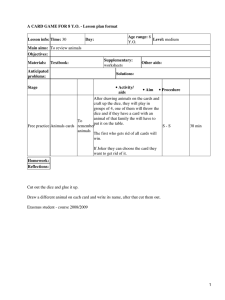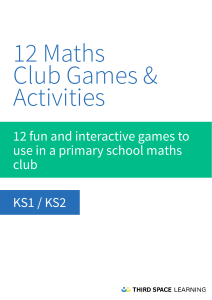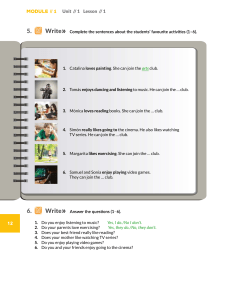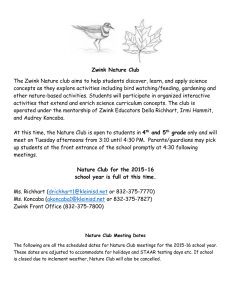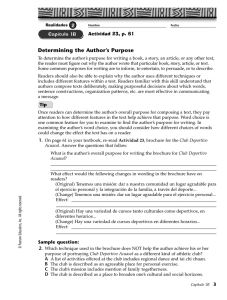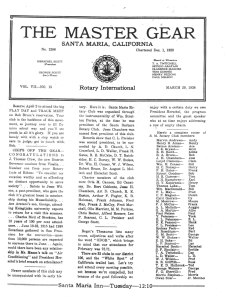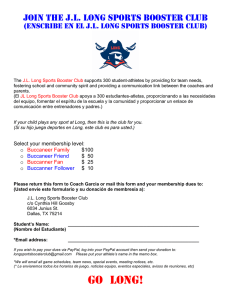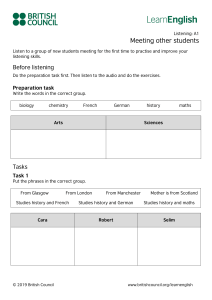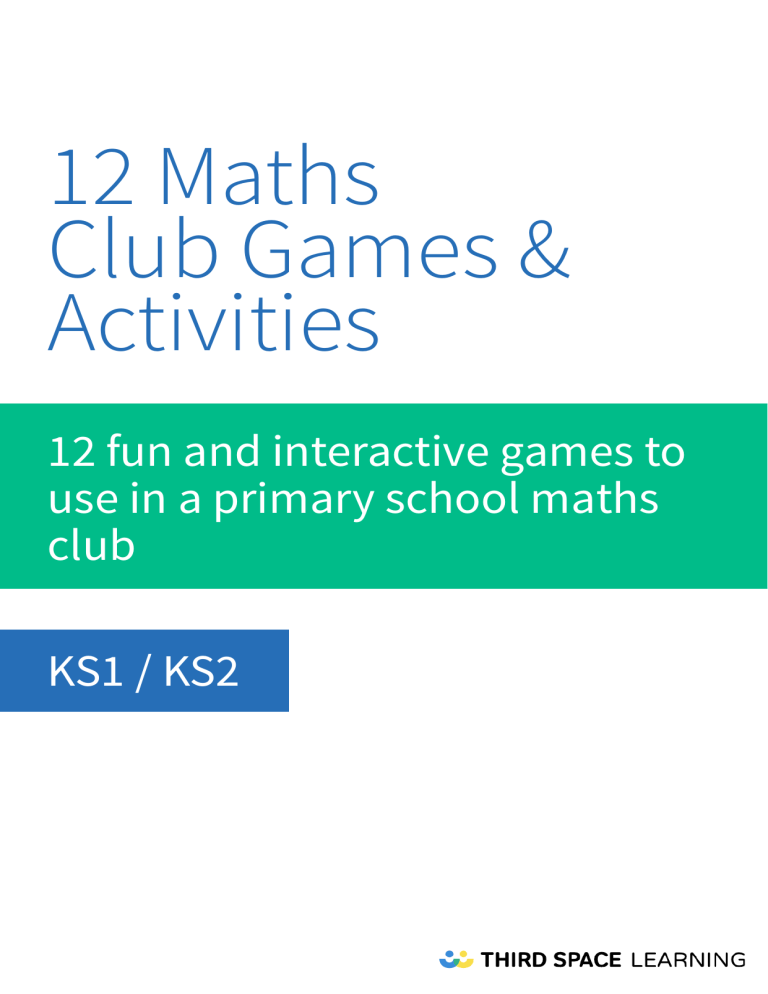
12 Maths Club Games & Activities 12 Maths Club Games & Activities 12 fun and interactive games to use in a primary school maths club KS1 / KS2 1 12 Maths Club Games & Activities Contents What to expect with these 12 Maths Club Games & Activities 2 Dice Duo3 Simple Subtraction4 The Angle Activity5 The Division Game6 Fractions Of A Minute Game7 Percentage Game8 The Card Sort Game9 Odd One Out10 Graphic Organisers11 Balloon Debates12 Diceland13 Snakes And Ladders14 For more free resources and intervention support go to thirdspacelearning.com 12 Maths Club Games & Activities What to expect with these 12 Maths Club Games & Activities The idea of starting a maths club is always great in theory, but in reality it can be a little more difficult to find the time with a very busy teaching schedule already in place. However, that’s why we are here to help! In this resource you will find 12 ready to use maths games and activities that are perfect for an after school maths club! There are activities and games that will help with all aspects of mathematics including times tables, reasoning and organisation, so there really is enough to keep your maths club busy for weeks! 2 For more free resources and intervention support go to thirdspacelearning.com 12 Maths Club Games & Activities Dice Duo This simple and fun activity is a fantastic way to teach your maths club about probability and chance. Using something that can be found in every primary classroom, namely two dice, the children will be excited to race in an attempt to win the game whilst testing out their multiplication skills! You will need • Two dice (the number will vary based upon participant numbers) • Whiteboards or books for each child How to run the activity 1. Separate your maths club into pairs and give each pair two dice. 2. Take turn to throw both dice and then multiply the two numbers on the dice to get your score. 3. Record the score in a table. 4. The winner is the first player to reach 100 points. Variations on the activity Variation Number 1: Ask each member of your maths club to throw both dice ten times and find their total score. They can then try this several times to see what their highest or lowest score is. Variation Number 2: Each child starts with a score of 100 and has to subtract the product of their dice throws each time. The first person to reach zero wins! 3 For more free resources and intervention support go to thirdspacelearning.com 12 Maths Club Games & Activities Simple Subtraction This is an activity which is quick to set up and requires minimal equipment, but is one that your club will love! The game is all about getting to the magic number of 27, but it may be trickier than first thought as tactical subtraction is involved! You will need • One die between everyone • Paper, whiteboards or workbooks to act as a scoresheet How to run the activity 1. Ask every child to draw out a scoresheet that looks like this: 2. Throw the die and ask all players to write the resulting numbers in one of their four boxes before the die is thrown again, noting that only one digit can be written in each box and that once a number is in a box it cannot be changed. 3. Continue like this, throwing the die until all four boxes are filled. 4. When all of the boxes have been filled, subtract the bottom 2-digit number from the one at the top. 5. If the bottom number is greater then they score 0 points. 6. The winner is the player whose answer is closest to 27. 7. The winner of each round scores 4 points, the next closest 3 points and so on. 8. Begin the next round! 4 For more free resources and intervention support go to thirdspacelearning.com 12 Maths Club Games & Activities The Angle Activity Keeping children busy and their minds active with just some dice and angles may seem like a tricky task, but not with this activity. It combines probability and chance with acute, obtuse and right angles and is a fantastic way to get a group of KS2 children thinking about which angle is which! You will need • Two dice How to run the activity 1. Draw the following (or a variation of it using your own angles) on the classroom whiteboard: 2. Get the children to take turns throwing the dice and then matching the total of the dice to one of the above images. 3. Look at the angles between the two lines and score accordingly: Acute Angle = 1 Point Obtuse Angle = 2 Points Right Angle = 3 Points 4. Play ten rounds and the winner is the player with the highest score! 5 For more free resources and intervention support go to thirdspacelearning.com 12 Maths Club Games & Activities The Division Game This game will help the children in your maths club think about division, whilst challenging them to complete a bingo style board in a race against their friends. You will need • Two dice per pair of children • A set of counters for each child • Whiteboards or workbooks How to run the activity 1. Ask each child to write the numbers 1-9 in a grid like the one below. The order does not matter as long as each number is in there once: 1 8 6 5 3 7 9 4 2 2. Take turns to throw the two dice and arrange the scores to make up a 2-digit number. E.g. it could be 23 or 32. 3. Place a counter on any of the squares that contain a number that divides into the 2-digit number. 4. The winner is the first player to have a straight line of three counters. 6 For more free resources and intervention support go to thirdspacelearning.com 12 Maths Club Games & Activities Fractions Of A Minute Game This activity is a real test of skill! It is all about using knowledge of time to judge how quickly it passes, and as we know, this can be a tricky task at the best of times. Pass the stopwatch around the children in the club and they will have a whale of a time! You will need • A stopwatch which measures seconds How to run the activity 1. Decide on a fraction you would like your class to break a minute down into. E.g. 1/3. 2. Ask the children to take turns to guess 1/3 of a minute by starting and stopping the stopwatch when they think the right amount of time has passed. 3. Record each of the guesses in a table. 4. The player who is closest wins the round. See below for an example of a table: 7 Fractions of a minute Time in seconds Ben’s Guess Sophie’s Guess 1/3 20 18 23 1/2 30 1/4 15 For more free resources and intervention support go to thirdspacelearning.com 12 Maths Club Games & Activities Percentage Game Percentages can often prove difficult for some in the classroom, but with this simple and fun activity the members of your maths club will be asking to learn about them every day! You will need • A blank cube • Two grids for each of the children that are participating How to run the activity 1. Begin by making a percentage dice by writing 5%, 10%, 15%, 20%, 25%, 30% and 35% on the faces of a blank cube. 2. Hand out worksheets (or get the children to create their own squares on a whiteboard) containing two 10x10 grids. 3. Get the children to take turns throwing the dice and shouting out the percentage that comes up on the dice. 4. The children will then colour in part of one of their blocks for each turn. They are not allowed to colour in part of one block and part of another one in the same go. 5. If the children are unable to colour the exact percentage of their square that matches the die percentage then they will need to skip their go. 6. The winner is the player to completely colour in both of their blocks first. 8 For more free resources and intervention support go to thirdspacelearning.com 12 Maths Club Games & Activities The Card Sort Game This activity encourages verbalisation amongst the children as they try to decide what each card in the deck has in common with the others! You will need • A deck of cards with statements on them of your choosing How to run the activity 1. Divide the children into small, mixed ability groups. 2. Instruct them to discuss the deck of cards they have in front of them until they can reach a consensus on how they should be sorted. 3. The categories the cards should be sorted into are ‘Agree’, ‘Disagree’, ‘It depends on’ and ‘Not sure’. 4. Let the children make sense of the cards themselves, identifying key words on the card to work out the context of it. 5. When the children have finished sorting the cards you can discuss the statements as a whole group and share the reasoning and thoughts behind each decision. 6. It is here that you will be able to take mathematical pictures of children’s understanding and capture areas of uncertainty or disagreements. This will allow you to set a learning agenda for future lessons. Discussions challenge thinking processes and are extremely valuable because children often change their ideas in light of other views. Some polygons have thickness Some polygons have curves Polyhedra are made up of curves All regular polygons tessellate The outside of a polygon is called a boundary Polygon interior angles always = 180 degrees Polygons can have as many sides as you want The corner of a polygon is called an apex Some polygons have more angles than sides The number of sides of a polygon is equal to the number of exterior angles A polygon can be equilateral without being equiangular All regular polygons are convex polygons A polygon is a union of segments 9 The sides of concave polygons are equal in size Not all polygons are closed figures All polygons are symmetrical Polygons have the same number of lines of symmetry as sides The angles in a polygon are congruent For more free resources and intervention support go to thirdspacelearning.com 12 Maths Club Games & Activities Odd One Out This task is all about reasoning and getting the children to explain why they have chosen the odd one out from a list. It is a great way to get critical thinking involved in your maths club! You will need • A series of questions to ask the group to establish which is the odd one out How to run the activity 1. Write up a series of investigations on the whiteboard for the group to delve into and establish which is the odd one out in each. Some examples include: 10 15 88 61 52 43 WHY? 64 16 36 82 144 WHY? 1 o’clock 4 o’clock 5 o’clock 8 o’clock WHY? 7426 9546 8547 2147 4328 WHY? 8547 is the odd one out because in the other numbers the first and last digit multiply together to make the digits in the middle and so 8 x 7 is not 54. 15 is the odd one out because it is the only number that does not have a digital root of 7. 82 is the odd one out because the other numbers are square numbers. 1 o’clock is the odd one out because the angle between both hands does not make an obtuse angle, whereas the others do. For more free resources and intervention support go to thirdspacelearning.com 12 Maths Club Games & Activities Graphic Organisers A classic way to help children organise visual information, graphic organisers are valuable assessment tools that you can use both in your maths club and in the classroom. You will need • Workbooks for each child How to run the activity Graphic organisers are a visual way to organise information and thoughts to help with understanding, memory and written work. They are valuable assessment tools because they are flexible, endless in application and show the order and completeness of children’s thought processes. This can demonstrate the strengths and weaknesses in their understanding. In this example, children are given one key word that they place on a familiarity line and then attempt to complete four boxes that delve into their understanding in more detail. For example: Scalene Triangle Sort of familiar Never heard of it 11 Explain in your own words what a scalene triangle is: Give an example of when you have seen one or used one: What facts do you know about this triangle: Draw a picture of a scalene triangle: I’m confident I know what it is For more free resources and intervention support go to thirdspacelearning.com 12 Maths Club Games & Activities Balloon Debates Another way to encourage verbalisation within a group, this task will give children the chance to show off their debating skills, whilst also using their maths reasoning ones too. Prepare for the room to get a little loud! You will need • Nothing apart from some debate topics! How to run the activity A balloon debate is a debate in which a number of speakers endeavour to win the support of the class. It takes its name from the hypothetical situation of being in a hot air balloon which is too heavy and rapidly losing height. Each speaker has to make the case as to why they should not be thrown out of the balloon to save the remainder. Typically speakers take a famous person, a profession or characters to speak on behalf of. In this case they’ll take numbers. Rather than being just a lot of hot air, balloon debates are a superb way to improve children’s speaking and listening skills, as well as their self-esteem and confidence. For example: 6 numbers are in a balloon: 3.14 10 0 1/2 2 6 Each number has a particular reason why they should be left in the balloon, but can you think of them? 12 For more free resources and intervention support go to thirdspacelearning.com 12 Maths Club Games & Activities Diceland This task will help children derive and recall multiplication facts up to 10 x 10, the corresponding division facts and multiples of numbers to 10 up to the tenth multiple. You will need • Two dice - one marked 3-8 and one marked 4-9 • Different coloured counters • Pencil and paper • 10 x 10 number grid How to run the activity 1. Give each pair of players a 10 x 10 number grid that contains all of the products possible from rolling the two dice. 2. Roll both dice and find the product. 3. Find the product on the number grid and cover the number made. 4. The first player to get four in a row horizontally, vertically or diagonally is the winner. Variations on the activity • The player to get a counter in each column is the winner. • The player to get four counters that make a square is the winner. • If you throw a double you get another go. • The first player to cover four square numbers is the winner. • Play for five minutes. Add together all the numbers you have covered. The player with the highest total is the winner. • Play the game with a smaller number grid using dice marked 1-6 and changing the numbers accordingly. Things to think about: • How many numbers have you covered that have three factors? • How many numbers have you covered that have a digital root of three? • When you land on a number can you name the place and face value of each digit? 13 For more free resources and intervention support go to thirdspacelearning.com 12 Maths Club Games & Activities Snakes And Ladders The aim of this game is to help children recognise that prime numbers have only two factors and identify prime numbers less than 100. It will enable them to use their knowledge of multiplication facts to derive squares of numbers up to 12 x 12 and grow their confidence with the times tables! You will need • Snakes and Ladders grid • One die labelled 1-6 • Different coloured counters • Square numbers and prime numbers crib sheet • Pencil and paper How to run the activity 1. The aim of the game is to progress from the start square to the finish square. 2. Throw the die to see who will go first. The lowest number starts. 3. Players take it in turns to throw the die and move that number of spaces forward. 4. If players land on a prime number, they move forward three spaces. If players land on a square number, they miss a go. If they land on thirteen, they go back to the start. 5. If players land at the base of a ladder they should climb the ladder to the top. If players land on the tail of a snake, they should slide to the head. 6. If players land on the same square, then both counters are returned to the start. 7. The first player to reach 100 is the winner. Variations on the activity • Alter the size of the grid to 12 x 12. • If you roll a six then have another turn. • You must roll the exact number to land on the finishing square. • Use two dice and add the scores together. • Label 1/10 of the squares with further instructions, e.g. move on six spaces, wait here until you throw an even prime number, miss a go etc. • Play with different rules, e.g. if you land on a multiple of six move back two spaces, if you land on a multiple of seven move forward two spaces. 14 For more free resources and intervention support go to thirdspacelearning.com 12 Maths Club Games & Activities 15 For more free resources and intervention support go to thirdspacelearning.com
